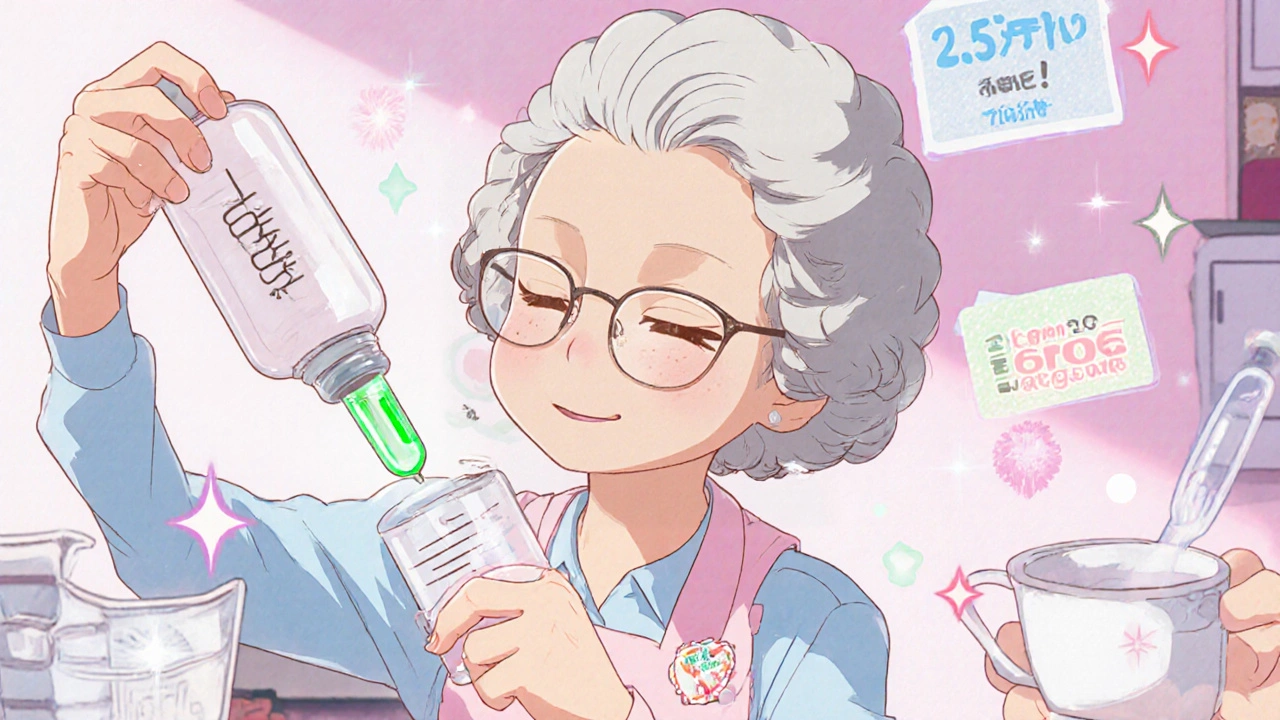Getting the right dose of medicine isn’t just about following instructions-it’s about seeing it clearly. When you’re giving liquid medicine to a child, helping an elderly parent, or managing a chronic condition at home, a tiny mistake can mean big consequences. A misplaced decimal, a misread line, or a shaky hand can turn a safe treatment into a dangerous one. That’s where visual dosing aids come in. These aren’t fancy gadgets-they’re simple tools designed to make accuracy obvious, even under stress.
Why Visual Dosing Matters
Medication errors are one of the most common causes of preventable harm in healthcare. The Institute of Medicine estimates that at least 1.5 million people in the U.S. suffer preventable adverse drug events every year. Many of these happen because of dosing mistakes with liquid medications. Parents guessing how much to give a toddler. Seniors mixing up milliliters and teaspoons. Nurses rushing during an emergency. These aren’t careless mistakes-they’re human errors made worse by confusing tools. Visual dosing aids fix this by turning abstract numbers into clear, visible cues. Instead of reading tiny numbers on a syringe, you see a colored band that says “safe dose.” Instead of counting drops, you fill a dropper until a window turns green. These tools cut through confusion and reduce cognitive load. In high-pressure moments-like a child having a seizure or someone having an allergic reaction-you don’t need to think. You just need to see.How Syringes Are Built for Accuracy
Not all syringes are created equal. Standard plastic syringes from the pharmacy often have fine lines, small numbers, and no contrast. That’s why many hospitals and clinics now use oral syringes with visual enhancements. These have:- Large, bold numbers in high-contrast colors (black on yellow, white on blue)
- Color-coded zones that match common pediatric doses (e.g., green for 2.5 mL, red for 5 mL)
- Eliminated unnecessary markings-only the most common doses are shown
- Non-slip grips and easy-to-read tips
Droppers That Don’t Lie
Droppers are everywhere-baby medicine, eye drops, tinctures. But most are terrible at measuring. The same dropper can deliver 0.3 mL one time and 0.7 mL the next, depending on how you hold it. That’s why visual droppers now come with built-in measurement windows. These aren’t just clear plastic tubes. They have:- Transparent chambers with etched, raised lines
- Color-changing indicators that turn blue or green when the correct volume is drawn
- Stop points that prevent overfilling
- Calibrated for specific medications (e.g., liquid acetaminophen, antiretrovirals)
Measuring Cups and Spoons That Actually Work
Household spoons are not medical tools. A teaspoon from your kitchen can vary by 2-3 mL. That’s a 30% error on a 5 mL dose. That’s why FDA guidelines now warn against using kitchen spoons for medicine. Instead, use calibrated measuring cups with:- Spouts for easy pouring
- Clear, raised lines for 2.5 mL, 5 mL, 10 mL
- Non-slip bases and ergonomic handles
- Color-coded labels matching common pediatric doses

Color-Coding: The Secret Weapon
Color isn’t just for decoration-it’s a universal language. Visual dosing aids use color to signal safety, warning, and action:- Green = Safe dose range
- Yellow = Caution-check weight or age
- Red = Maximum dose-do not exceed
What Doesn’t Work
Not every “visual aid” is actually helpful. Some tools look good but fail under pressure:- Syringes with too many lines-overcrowded markings cause confusion
- Color schemes that don’t match standard medical codes (e.g., red for low dose)
- Tools that require memorizing a legend-people forget under stress
- Non-standard units (e.g., “1 capful” instead of mL)
Training and Adoption
You don’t need a 2-hour course to use a visual dosing aid. But you do need to see it in action once. Hospitals now include visual dosing tools in simulation drills. Parents get a quick demo from pharmacists when picking up liquid prescriptions. The goal isn’t perfection-it’s reduction. Many pharmacies now offer free visual dosing kits with pediatric prescriptions. These include:- A color-coded oral syringe
- A measuring cup
- A simple chart showing weight-based doses

Real-World Impact
In one pediatric clinic in Ohio, switching to visual dosing tools reduced medication errors by 73% in six months. In a nursing home in Florida, staff reported fewer arguments with families about “how much to give.” In emergency rooms, nurses said they felt more confident during code situations. One mother, caring for her son on daily antiretroviral therapy, said: “Before, I’d stare at the syringe for five minutes, terrified I’d mess up. Now, I just fill it to the green line. I don’t have to think. I just do.”What to Look For When Buying
When choosing a visual dosing tool, ask:- Is it labeled in milliliters (mL)? Avoid teaspoons or “caps.”
- Are the markings bold and high-contrast?
- Does it have color zones matching common doses?
- Is it compatible with my medication bottle?
- Has it been tested in clinical settings?
Final Thoughts
Visual dosing aids aren’t magic. They won’t replace training, communication, or good systems. But they do something rare in healthcare: they make safety obvious. In a world full of complex instructions and high-stakes decisions, sometimes the best solution is the simplest one-see the dose, trust the color, give the right amount.When every drop counts, don’t guess. See it. Measure it. Give it with confidence.
Are visual dosing aids only for children?
No. While they’re especially helpful for children due to weight-based dosing, visual dosing aids benefit anyone who takes liquid medications-especially seniors, people with vision impairments, or those managing multiple drugs. Color-coded syringes and measuring cups reduce confusion for adults on blood thinners, insulin, or seizure medications too.
Can I use a kitchen spoon if I don’t have a syringe?
No. Kitchen spoons vary widely in size-a teaspoon can hold anywhere from 3 to 7 milliliters. That’s a dangerous range for medication. Always use a calibrated oral syringe or measuring cup. If you don’t have one, ask your pharmacist for a free dosing tool-they’re often provided at no cost.
Do visual dosing aids work for eye drops or nasal sprays?
Most visual dosing aids are designed for oral liquid medications. Eye drops and nasal sprays usually come with pre-measured doses or built-in applicators. Always follow the manufacturer’s instructions. If you’re unsure how many drops to use, ask your pharmacist for a dropper with calibrated markings.
Why do some syringes have only 3 lines while others have 10?
Syringes with fewer lines are designed for simplicity. Too many markings cause confusion, especially in emergencies. High-quality visual dosing syringes show only the most common doses (like 1 mL, 2.5 mL, 5 mL) and use color zones for ranges. The goal isn’t precision down to 0.1 mL-it’s avoiding dangerous mistakes.
Are visual dosing aids covered by insurance?
Many insurance plans and Medicaid programs cover dosing tools when prescribed for chronic conditions. Some pharmacies provide them for free with pediatric prescriptions. If you’re paying out-of-pocket, basic visual syringes cost under $5. They’re a small investment compared to the cost of a medication error.



Comments
My grandma used to guess doses with a kitchen spoon and swear she was fine. Then she ended up in the ER after mixing up her blood pressure med. I got her one of those color-coded syringes last year. She doesn’t even look at the bottle anymore-just fills to the green. Life changed. Seriously. 🙏
Did you know the FDA doesn’t even require these tools to be tested in real homes? They’re just pushed by pharma reps who get kickbacks. I saw a nurse use one of these ‘visual’ syringes and she still got it wrong-because the color faded after three washes. This whole thing is a scam to sell more plastic.
Visual dosing isn’t just about safety-it’s about dignity. When you’re old, tired, or scared, you don’t need to solve math problems just to give your kid medicine. These tools say: ‘You’re not dumb. You’re just human.’ And that’s worth more than any study. I’ve handed out a hundred of these to parents at my clinic. No one ever thanked me. But I saw their shoulders drop. That’s the win.
From a clinical pharmacology standpoint, the cognitive load reduction via chromatic encoding aligns with dual-coding theory-visual and linguistic pathways are decoupled under stress, enhancing retrieval fidelity. The 2018 Gardner study’s p-value of <0.01 confirms statistical significance, but the ecological validity is limited by simulated environments. Real-world adherence metrics remain underreported in literature. We need longitudinal studies with EEG biomarkers to quantify neural efficiency gains.
Oh please. These ‘visual aids’ are just infantilizing adults. If you can’t read a syringe, maybe you shouldn’t be handling medication. This is the same logic that gave us ‘easy-read’ medicine labels for people who can’t read. It’s not helping-it’s enabling dependency. Real responsibility means learning the metric system.
Ugh. I used one of these ‘color-coded’ syringes and the green was so faint I thought it was a stain. Then I gave my kid half the dose because I was ‘being safe.’ Now I just use a digital scale and a calculator. If you can’t do basic math, maybe don’t be a parent.
THEY’RE WATCHING US. 😱 The syringes have microchips. The colors change when you’re near a hospital. I saw a guy in the pharmacy cry because his ‘red zone’ turned blue after he used it. He said ‘they knew.’ I’m not joking. This is how they track who’s taking what. 💉👁️
I work in a rural clinic in Maine. We switched to these tools two years ago. The difference? Parents stopped showing up in tears. Nurses stopped yelling. Kids stopped crying before they even saw the syringe. It’s not about tech. It’s about trust. These tools say: ‘We see you. We know this is hard.’ And that’s everything.
While the utility of visual dosing aids is empirically supported, one must acknowledge the potential for overreliance. The human element-verbal confirmation, double-checking, and caregiver education-remains irreplaceable. Tools are prosthetics, not replacements. A syringe with color zones cannot substitute for a calm, informed caregiver. The goal is augmentation, not automation.
Wow. So instead of teaching people to read, we just give them crayons? 🤦♀️ Next they’ll make the medicine bottle hum when you’ve got the right amount. This is what happens when you let design people run healthcare.
My sister’s a nurse in the NICU and she swears by these syringes. Said they cut down her stress like 80%. One time she had to give a preemie 1.2 mL at 3am, exhausted, and she just looked at the green line and did it. No panic. No shaking. No mistakes. That’s the real win. Not the fancy stats. The quiet moment when someone breathes again.
THEY’RE HIDING THE TRUTH. The red zone isn’t for overdose-it’s for when they want you to die. I found a hidden code in the syringe’s plastic. It says ‘DOSING IS CONTROL’ in tiny letters. My cousin died from a ‘mistake.’ I know what’s happening. They want us scared. So we keep buying their tools. 💔
Oh wow, a whole article about syringes. How groundbreaking. Meanwhile, in the real world, people are dying because their insurance won’t cover insulin. But sure, let’s talk about whether the green line is 0.1 mL off. This is why healthcare is broken-you all obsess over tiny fixes while the whole system is on fire.
There’s a quiet power in simplicity. When you remove the fear of math, you restore agency. These tools don’t make people dependent-they make people capable. I’ve watched elderly patients who once avoided medication altogether now take it confidently. That’s not a gimmick. That’s healing.
You think this is about safety? It’s about control. They don’t want you to know how much you’re really getting. The colors are a distraction. The real dose is in the bottle’s hidden layer. I’ve seen it. The syringes are calibrated to deliver 10% less. They’re rationing. 💊